Grey-Black Optical Solitons, Homoclinic Breather, Combined Solitons via Chupin Liu’s Theorem for Improved Perturbed NLSE with Dual-Power Law Nonlinearity
Abstract
1. Introduction
2. Dual-Power Nonlinearity
3. Grey and Black Optical Solitons (GBOS)
- Constants:
- :
- ::
- ::
- :
3.1. Type 1: Grey Optical Soliton (GOS) ()
3.2. Type 2: Black Optical Soliton (BOS) ()
4. Optical Solitons Extension via Chupin Liu’s Theorem (CLT)
5. COS Category-I
6. COS Category-II
7. Multiwaves Solitons
- Set I.
- Set II. When
8. HB Approach
- Set I. When
- Set II. When
9. Evaluation of M-Shape Solitons
- Set I. When ,
- Set II. When ,
10. One-Kink Interaction for M-Shape Soliton
- Set I. If ,
- Set II. When ,
11. Two-Kink Interaction for M-Shape Soliton
- Set I.
12. Results and Discussion
13. Conclusions
Author Contributions
Funding
Data Availability Statement
Acknowledgments
Conflicts of Interest
References
- Baldelli, L.; Filippucci, R. Singular quasilinear critical Schrodinger equations in RN. Commun. Pure Appl. Anal. 2022, 21, 2561–2586. [Google Scholar] [CrossRef]
- Filippucci, R.; Pucci, P.; Souplet, P. A Liouville-type theorem in a half-space and its applications to the gradient blow-up behavior for superquadratic diffusive Hamilton-Jacobi equations. Comm. Partial. Differ. Equations 2020, 45, 321–349. [Google Scholar] [CrossRef]
- Seadawy, A.R.; Ahmed, S.; Rizvi, S.T.; Nazar, K. Applications for mixed Chen–Lee–Liu derivative nonlinear Schrödinger equation in water wave flumes and optical fibers. Optical Quantum Electron. 2023, 55, 34. [Google Scholar] [CrossRef]
- Seadawy, A.R.; Rizvi, S.T.; Ahmed, S.; Ahmad, A. Study of dissipative NLSE for dark and bright, multiwave, breather and M-shaped solitons along with some interactions in monochromatic waves. Opt. Quantum Electron. 2022, 54, 782. [Google Scholar] [CrossRef]
- Ahmed, S.; Seadawy, A.R.; Rizvi, S.T. Study of breathers, rogue waves and lump solutions for the nonlinear chains of atoms. Opt. Quantum Electron. 2022, 54, 320. [Google Scholar] [CrossRef]
- Ali, K.; Seadawy, A.R.; Ahmed, S.; Rizvi, S.T. Discussion on rational solutions for Nematicons in liquid crystals with Kerr Law. Chaos Solitons Fractals 2022, 160, 112218. [Google Scholar] [CrossRef]
- Seadawy, A.R.; Rizvi, S.T.; Ahmed, S. Weierstrass and Jacobi elliptic, bell and kink type, lumps, Ma and Kuznetsov breathers with rogue wave solutions to the dissipative nonlinear Schrödinger equation. Chaos Solitons Fractals 2022, 160, 112258. [Google Scholar] [CrossRef]
- Khater, A.H.; Obied Allah, M.H. Effects of rotation on Rayleigh-Taylor instabilities of an accelerating, compressible, perfectly conducting plane layer. Astrophys. Space Sci. 1984, 106, 245–255. [Google Scholar] [CrossRef]
- Helal, M.A. A Chebyshev spectral method for solving Korteweg–de Vries equation with hydrodynamical application. Chaos Solitons Fractals 2001, 12, 943–950. [Google Scholar] [CrossRef]
- Helal, M.A.; Mehanna, M.S. A comparative study between two different methods for solving the general Korteweg–de Vries Equation (GKdV). Chaos Solitons Fractals 2007, 33, 725–739. [Google Scholar] [CrossRef]
- Seadawy, A.R.; Cheemaa, N. Propagation of nonlinear complex waves for the coupled nonlinear Schrödinger Equations in two core optical fibers. Phys. A Stat. Mech. Appl. 2019, 529, 121330. [Google Scholar] [CrossRef]
- Ghaffar, A.; Ali, A.; Ahmed, S.; Akram, S.; Baleanu, D.; Nisar, K.S. A novel analytical technique to obtain the solitary solutions for nonlinear evolution equation of fractional order. Adv. Differ. Equ. 2020, 2020, 308. [Google Scholar] [CrossRef]
- Wazwaz, A.M. Higher dimensional nonlinear Schrödinger equations in anomalous dispersion and normal dispersive regimes: Bright and dark optical solitons. Optik 2020, 222, 165327. [Google Scholar] [CrossRef]
- Cheemaa, N.; Seadawy, A.R.; Chen, S. More general families of exact solitary wave solutions of the nonlinear Schrodinger equation with their applications in nonlinear optics. Eur. Phys. J. Plus 2018, 133, 547. [Google Scholar] [CrossRef]
- Arshad, M.; Seadawy, A.; Lu, D.; Wang, J. Travelling wave solutions of generalized coupled Zakharov–Kuznetsov and dispersive long wave equations. Results Phys. 2016, 6, 1136–1145. [Google Scholar] [CrossRef]
- Helal, M.A. Solitons, A Volume in the Encyclopedia of Complexity and Systems Science, 2nd ed.; Springer Science: Berlin, Germany, 2022. [Google Scholar]
- Seadawy, A.R. Stability analysis of traveling wave solutions for generalized coupled nonlinear KdV equations. Appl. Math. Inf. Sci. 2016, 10, 209–214. [Google Scholar] [CrossRef]
- Seadawy, A.R.; Iqbal, M.; Lu, D. Application of mathematical methods on the ion sound and Langmuir waves dynamical systems. Praman-J. Phys. 2019, 93, 10. [Google Scholar] [CrossRef]
- Liu, Y.; Li, B.; Wazwaz, A.M. Novel high-order breathers and rogue waves in the Boussinesq equation via determinants. Int. J. Mod. Phys. B 2020, 43, 3701–3715. [Google Scholar] [CrossRef]
- Shah, K.; Seadawy, A.R.; Arfan, M. Evaluation of one dimensional fuzzy fractional partial differential equations. Alex. Eng. J. 2020, 59, 3347–3353. [Google Scholar] [CrossRef]
- Wang, J.; Shehzad, K.; Seadawy, A.R. Muhammad Arshad and Farwa Asmat, Dynamic study of multi-peak solitons and other wave solutions of new coupled KdV and new coupled Zakharov–Kuznetsov systems with their stability. J. Taibah Univ. Sci. 2023, 17, 2163872. [Google Scholar] [CrossRef]
- Wazwaz, A.M.; Mehanna, M. Bright and dark optical solitons for a new (3+ 1)-dimensional nonlinear Schrödinger equation. Optik 2021, 241, 166985. [Google Scholar] [CrossRef]
- Triki, H.; Biswas, A.; Milovic, D.; Belic, M. Chirped femtosecond pulses in the higher-order nonlinear Schrödinger equation with non-Kerr nonlinear terms and cubic–quintic–septic nonlinearities. Opt. Commun. 2016, 366, 362–369. [Google Scholar] [CrossRef]
- Taghizadeh, N.; Mirzazadeh, M.; Farahrooz, F. Exact solutions of the nonlinear Schrödinger equation by the first integral method. J. Math. Anal. Appl. 2011, 374, 549–553. [Google Scholar] [CrossRef]
- Seadawy, A.R. The generalized nonlinear higher order of KdV equations from the higher order nonlinear Schrödinger equation and its solutions. Optik 2017, 139, 31–34. [Google Scholar] [CrossRef]
- Chen, J.; Luan, Z.; Zhou, Q.; Alzahrani, A.K.; Biswas, A.; Liu, W. Periodic soliton interactions for higher-order nonlinear Schrödinger equation in optical fibers. Nonlinear Dyn. 2020, 100, 2817–2821. [Google Scholar] [CrossRef]
- Savaissou, N.; Gambo, B.; Rezazadeh, H.; Bekir, A.; Doka, S.Y. Exact optical solitons to the perturbed nonlinear Schrödinger equation with dual-power law of nonlinearity. Opt. Quantum Electron. 2020, 52, 318. [Google Scholar] [CrossRef]
- Kudryashov, N.A. Almost general solution of the reduced higher-order nonlinear Schrödinger equation. Optik 2021, 230, 166347. [Google Scholar] [CrossRef]
- Kudryashov, N.A. Optical solitons of the resonant nonlinear Schrödinger equation with arbitrary index. Optik 2021, 235, 166626. [Google Scholar] [CrossRef]
- Ma, G.; Zhao, J.; Zhou, Q.; Biswas, A.; Liu, W. Soliton interaction control through dispersion and nonlinear effects for the fifth-order nonlinear Schrödinger equation. Nonlinear Dyn. 2021, 106, 2479–2484. [Google Scholar] [CrossRef]
- Wang, K.J.; Wang, G.D. Variational theory and new abundant solutions to the (1+ 2)-dimensional chiral nonlinear Schrödinger equation in optics. Phys. Lett. A 2021, 412, 127588. [Google Scholar] [CrossRef]
- Mo, Y.; Ling, L.; Zeng, D. Data-driven vector soliton solutions of coupled nonlinear Schrödinger equation using a deep learning algorithm. Phys. Lett. A 2022, 421, 127739. [Google Scholar] [CrossRef]
- Jiang, C.; Cui, J.; Qian, X.; Song, S. High-order linearly implicit structure-preserving exponential integrators for the nonlinear Schrödinger equation. J. Sci. Comput. 2022, 90, 66. [Google Scholar] [CrossRef]
- Weng, W.; Zhang, G.; Zhang, M.; Zhou, Z.; Yan, Z. Semi-rational vector rogon-soliton solutions and asymptotic analysis for any n-component nonlinear Schrödinger equation with mixed boundary conditions. Phys. D Nonlinear Phenom. 2022, 432, 133150. [Google Scholar] [CrossRef]
- Biswas, A.; Ekici, M.; Sonmezoglu, A.; Arshed, S.; Belic, M. Optical soliton perturbation with full nonlinearity by extended trial function method. Opt. Quantum Electron. 2017, 44, 125–138. [Google Scholar] [CrossRef]
- Ekici, M.; Sonmezoglu, A.; Zhou, Q.; Moshokoa, S.P.; Ullah, M.Z.; Arnous, A.H.; Belic, M. Analysis of optical solitons in nonlinear negative-indexed materials with anti-cubic nonlinearity. Opt. Quantum Electron. 2019, 53, 715. [Google Scholar] [CrossRef]
- Seadawy, A.R.; Rizvi, S.T.; Ashraf, M.A.; Younis, M.; Hanif, M. Rational solutions and their interactions with kink and periodic waves for a nonlinear dynamical phenomenon. Int. J. Mod. Phys. B 2021, 35, 2150236. [Google Scholar] [CrossRef]
- Manafian, J.; Mohammadi Ivatloo, B.; Abapour, M. Breather wave, periodic, and cross-kink solutions to the generalized Bogoyavlensky-Konopelchenko equation. Math. Methods Appl. Sci. 2020, 43, 1753–1774. [Google Scholar] [CrossRef]
- Alsallami, S.A.M.; Rizvi, S.T.R.; Seadawy, A.R. Study of Stochastic–Fractional Drinfel’d–Sokolov–Wilson Equation for M-Shaped Rational, Homoclinic Breather, Periodic and Kink-Cross Rational Solutions. Mathematics 2023, 11, 1504. [Google Scholar] [CrossRef]
- Aliyu, A.I.; Tchier, F.; Inc, M.; Yusuf, A.; Baleanu, D. Dynamics of optical solitons, multipliers and conservation laws to the nonlinear Schrödinger equation in (2+1)-dimensions with non-Kerr law nonlinearity. J. Mod. Opt. 2019, 1950, 1162–1174. [Google Scholar] [CrossRef]
- Ahmed, I.; Seadawy, A.R.; Lu, D. Kinky breathers, W-shaped and multi-peak solitons interaction in (2+1)-dimensional nonlinear Schrödinger equation with Kerr law of nonlinearity. Eur. Phys. J. Plus 2019, 134, 1–10. [Google Scholar] [CrossRef]
- Ahmed, I.; ASeadawy, R.; Lu, D. M-shaped rational solitons and their interaction with kink waves in the Fokas–Lenells equation. Phys. Scr. 2019, 94, 055205. [Google Scholar] [CrossRef]










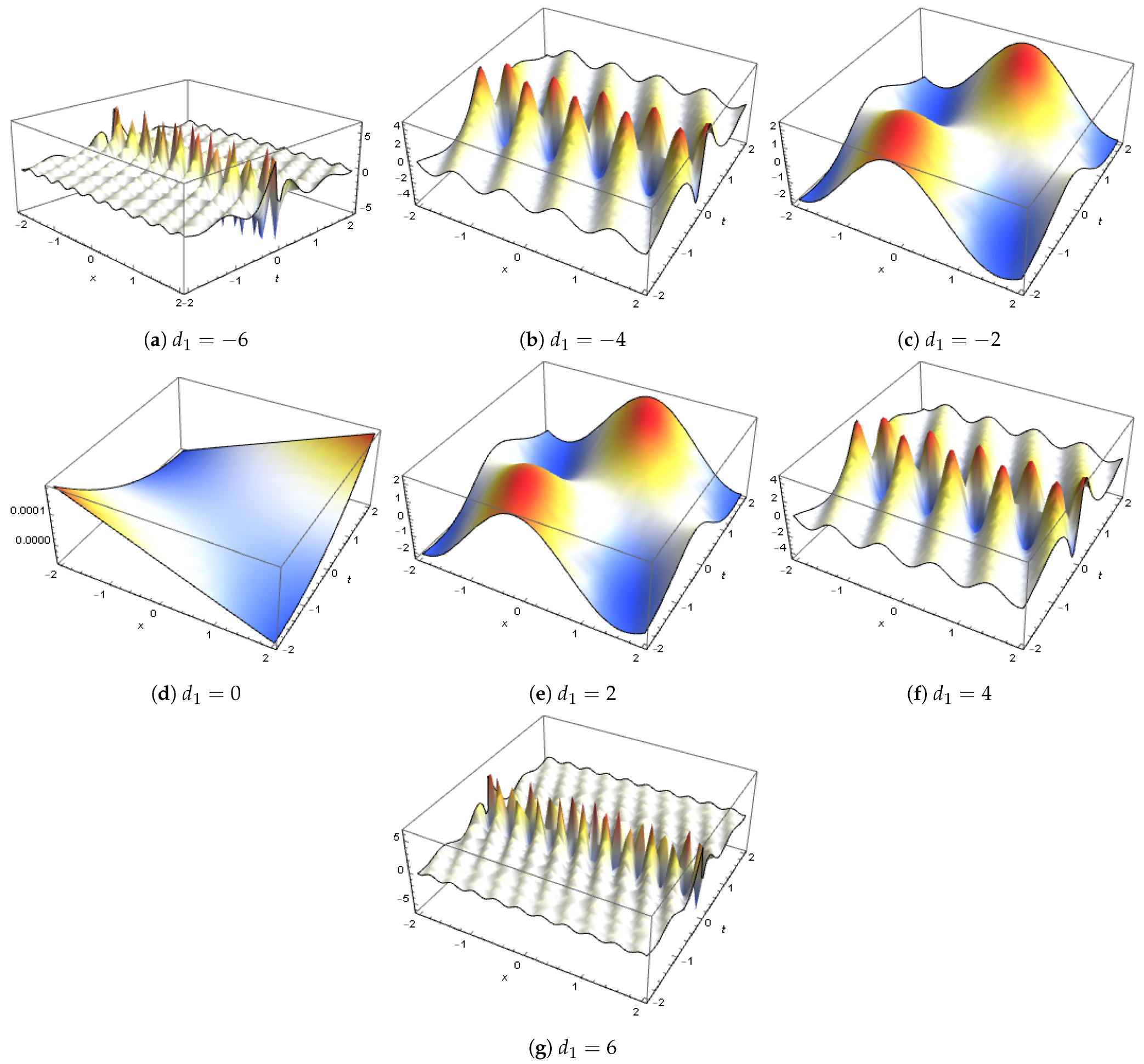
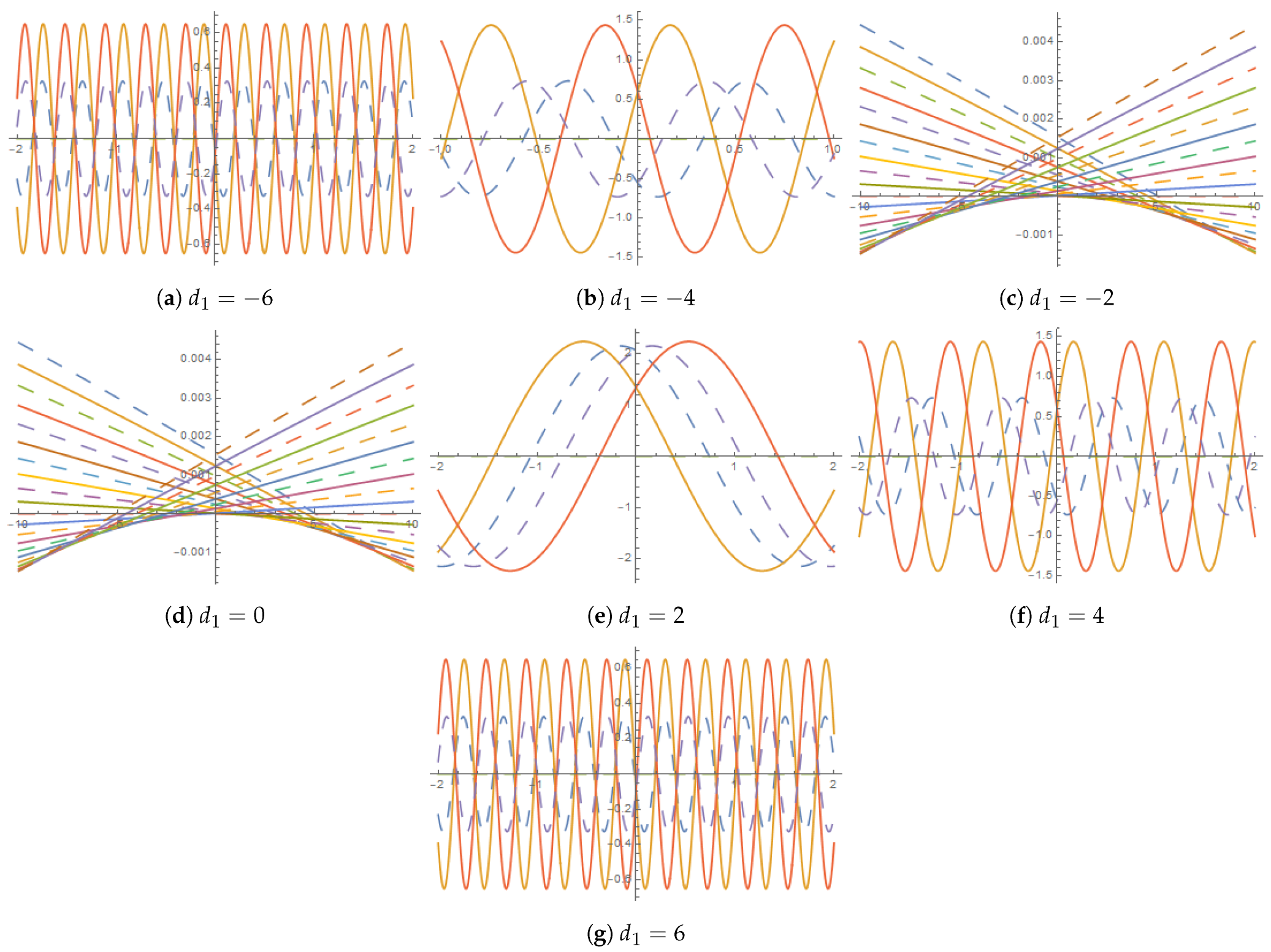

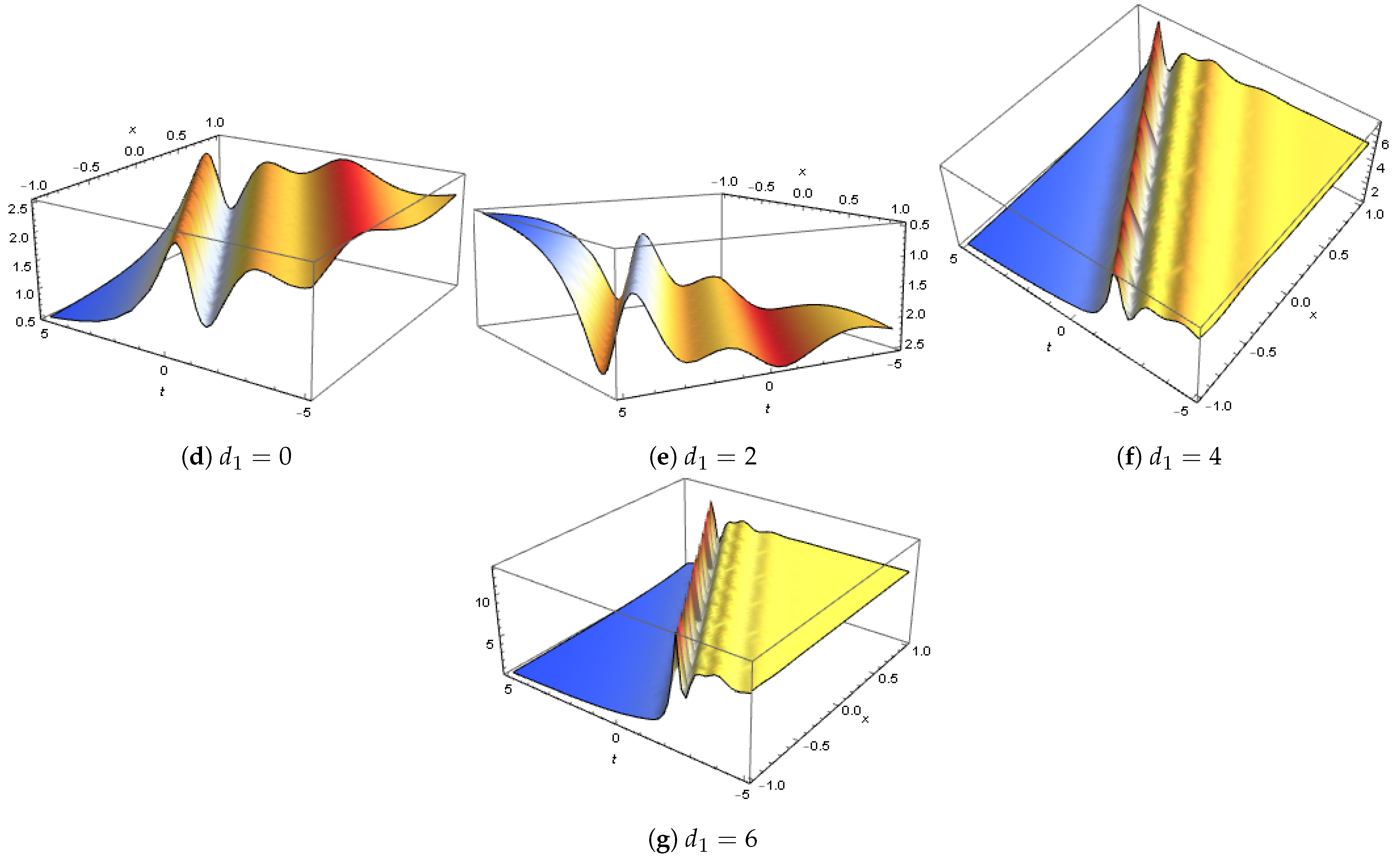
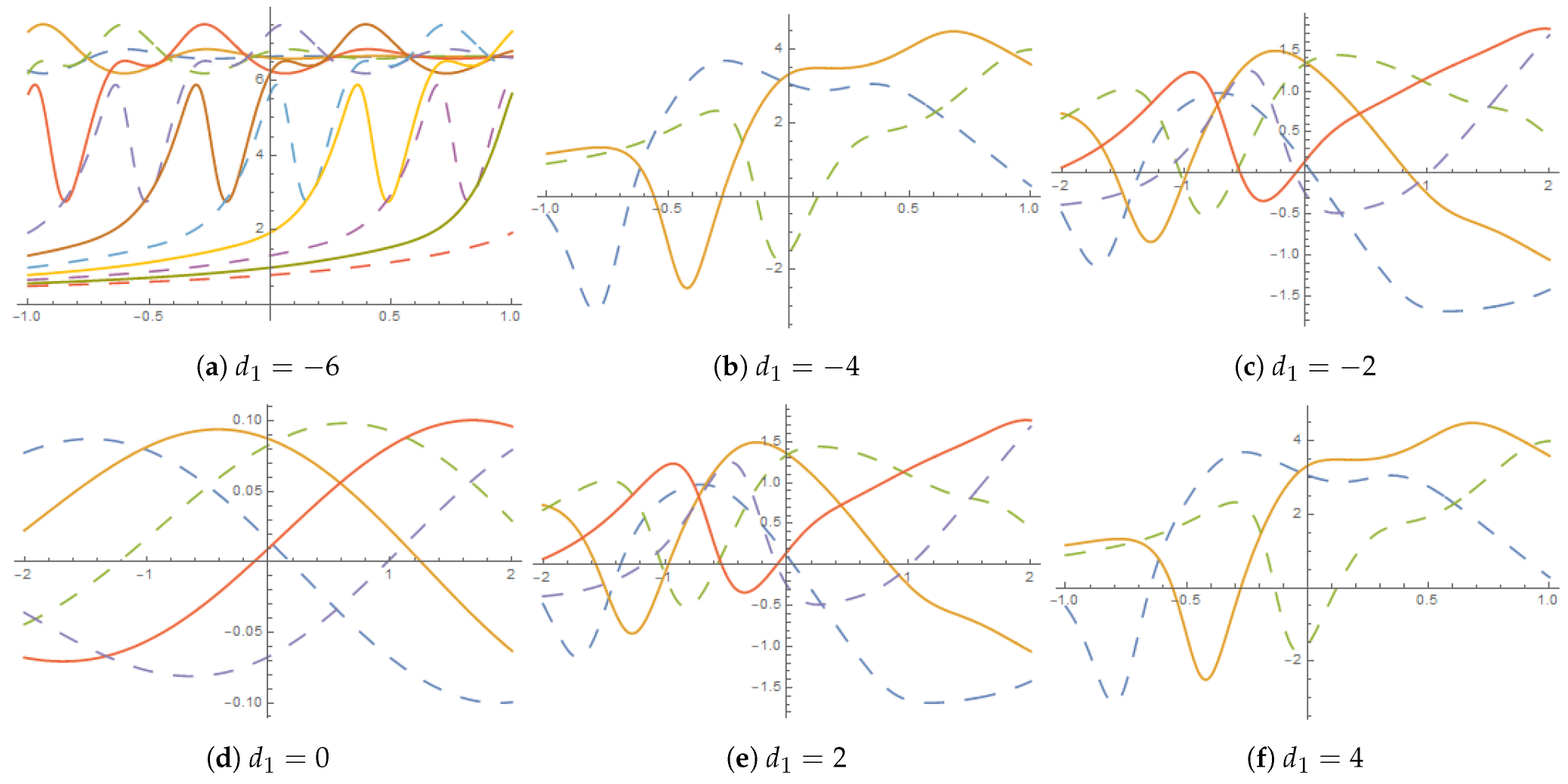
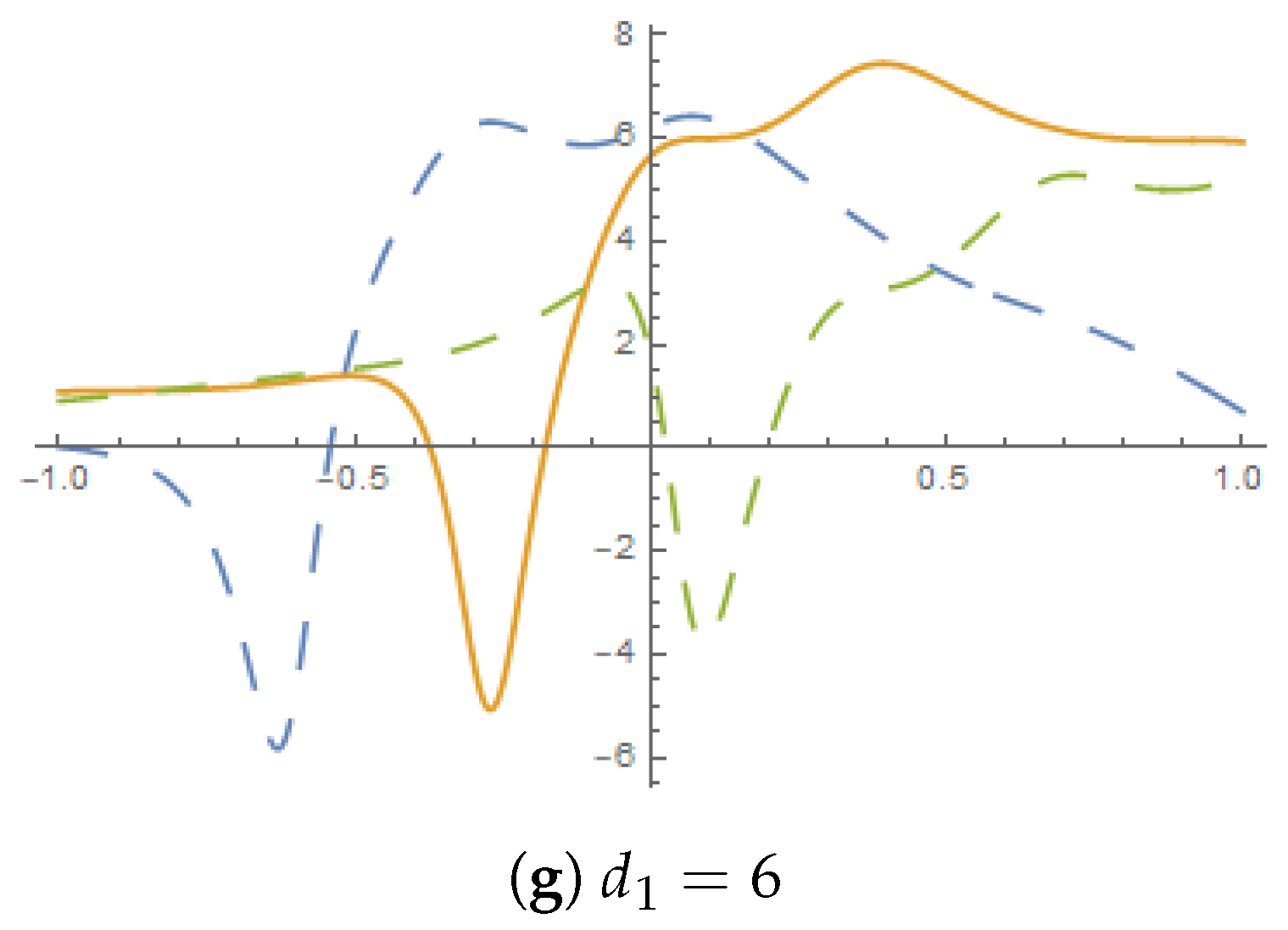
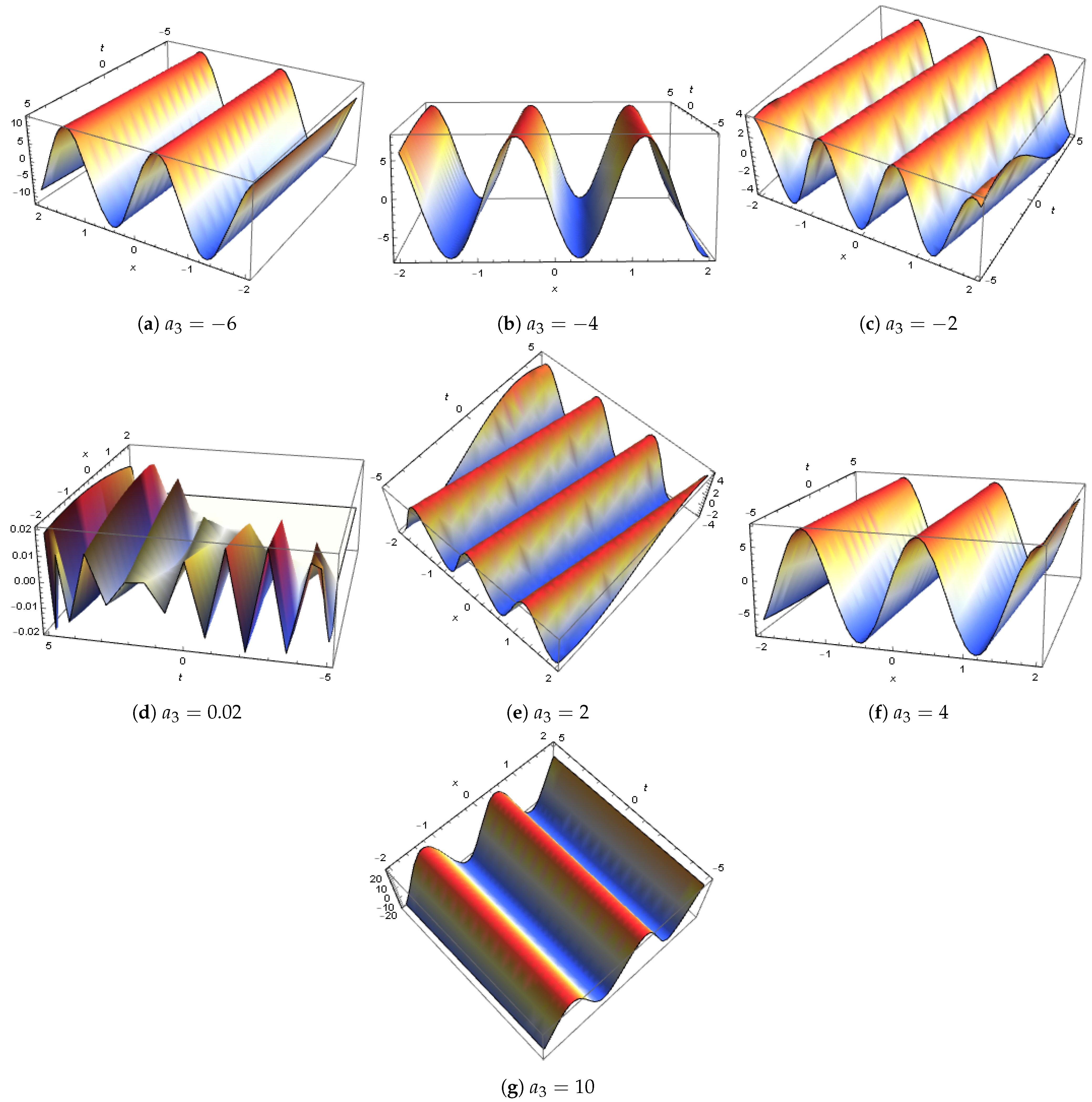
Disclaimer/Publisher’s Note: The statements, opinions and data contained in all publications are solely those of the individual author(s) and contributor(s) and not of MDPI and/or the editor(s). MDPI and/or the editor(s) disclaim responsibility for any injury to people or property resulting from any ideas, methods, instructions or products referred to in the content. |
© 2023 by the authors. Licensee MDPI, Basel, Switzerland. This article is an open access article distributed under the terms and conditions of the Creative Commons Attribution (CC BY) license (https://creativecommons.org/licenses/by/4.0/).
Share and Cite
Rizvi, S.T.R.; Seadawy, A.R.; Alsallami, S.A.M. Grey-Black Optical Solitons, Homoclinic Breather, Combined Solitons via Chupin Liu’s Theorem for Improved Perturbed NLSE with Dual-Power Law Nonlinearity. Mathematics 2023, 11, 2122. https://doi.org/10.3390/math11092122
Rizvi STR, Seadawy AR, Alsallami SAM. Grey-Black Optical Solitons, Homoclinic Breather, Combined Solitons via Chupin Liu’s Theorem for Improved Perturbed NLSE with Dual-Power Law Nonlinearity. Mathematics. 2023; 11(9):2122. https://doi.org/10.3390/math11092122
Chicago/Turabian StyleRizvi, Syed T. R., Aly R. Seadawy, and Shami A. M. Alsallami. 2023. "Grey-Black Optical Solitons, Homoclinic Breather, Combined Solitons via Chupin Liu’s Theorem for Improved Perturbed NLSE with Dual-Power Law Nonlinearity" Mathematics 11, no. 9: 2122. https://doi.org/10.3390/math11092122
APA StyleRizvi, S. T. R., Seadawy, A. R., & Alsallami, S. A. M. (2023). Grey-Black Optical Solitons, Homoclinic Breather, Combined Solitons via Chupin Liu’s Theorem for Improved Perturbed NLSE with Dual-Power Law Nonlinearity. Mathematics, 11(9), 2122. https://doi.org/10.3390/math11092122








